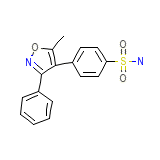Bextra




Categoria
Bextra Marchi, Bextra Analoghi
Bextra Marchi miscela
Bextra Formula chimica
Bextra RX link
Bextra FDA foglio
Bextra DMS (foglio di materiale di sicurezza)
Bextra Sintesi di riferimento
Bextra Peso molecolare
Bextra Temperatura di fusione
Bextra H2O Solubilita
Bextra Stato
Bextra LogP
Bextra Forme di dosaggio
Bextra Indicazione
Bextra Farmacologia
Bextra Assorbimento
Bextra Tossicita
Bextra Informazioni paziente
BEXTRA can cause GI discomfort and, rarely, more serious GI side effects, which may result in hospitalization and even fatal outcomes. Although serious GI tract ulcerations and bleeding can occur without warning symptoms, patients should be alert for the signs and symptoms of ulcerations and bleeding, and should ask for medical advice when observing any indicative sign or symptoms. Patients should be apprised of the importance of this follow-up Effects ó Risk of GI Ulceration, Bleeding, and Perforation).
Patients should report to their physicians, signs or symptoms of gastrointestinal ulceration or bleeding, skin rash, weight gain, or edema.
Patients should be informed of the warning signs and symptoms of hepatotoxicity (e.g., nausea, fatigue, lethargy, pruritus, jaundice, right upper quadrant tenderness, and flu-like symptoms). If these occur, patients should be instructed to stop therapy and seek immediate medical attention.
Patients should also be instructed to seek immediate emergency help in the case of an anaphylactoid reaction.
In late pregnancy, BEXTRA should be avoided because it may cause premature closure of the ductus arteriosus.














